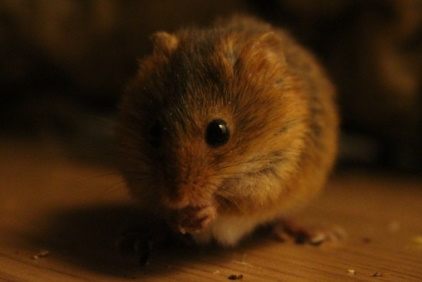Harvest Mice Behaviour
Harvest mice must be introduced at a young age to have the most chances of remaining stable and should be kept in pairs or small groups. Adult introductions are difficult and do not seem to have a high success rate. Same sex groups of either gender can be kept, with the mice often sleeping together in one nest.
Colony Aggression
Harvest mice pairs or colonies of Harvest mice can breakdown quite abruptly so must be monitored carefully with spare, secure tanks or vivariums available in case they need to be separated. The first warning sign of this can be some sniffing followed by one mouse leaping after the other and chasing it around the habitat, with the victim making abrupt, jerky movements or jumps away from the aggressor. This may then lead to a harvest mouse missing part of the end of their tail or having bites on their rear. If this persists, that it is important to separate as otherwise the victim may be killed.
Having more than one food bowl, and sprays of millet may help defuse the situation - it is vital to make sure that no mouse is bullied to the extent that they are no longer able to eat or drink in peace. Increasing the size of their enclosure may help, and personally I also recommend the use of the small silent spinner wheel. The mice can run side by side on this and it helps them use up their huge stocks of energy!
General Behaviour as pets
Harvest mice are virtually odourless and make a low maintenance pet if kept in male or female gender groups. They rarely bite providing they are handled well and some can be very friendly.
Breeding requires more vigilance since they do live in family groups or colonies as peacefully as other mouse species and can have outbreaks of violence.
If supplied with enough material a pet harvest mice will construct their own spherical nests to sleep in. Coconut fibre used for nesting birds such as finches can make a good material as well as plenty of hay and bedding.
Harvest mice jump and climb very well, using their prehensile tail as a fifth limb so it is important to furnish your Harvest Mice Environment with plenty of climbing material. The length of their jumps relative to their size is quite impressive, and if startled they may leap or ping a good 30cm.
Harvest mice can sense vibrations through the soles of their feet, allowing them to sense when a larger animal is nearby. They are cathemeral which means they are active at both night and day, with dusk being the most popular time. Harvest mouse behaviour has bursts of heavy almost manic activity followed by long naps. Harvest mice do not hibernate but would naturally spend most of winter underground so in winter you may observe less activity.
In captivity, it is important to let harvest mice exhibit as wild a range of behaviour as possible. Pet Harvest mice are unlikely to be bothered by household noise, but must not be kept in direct sunlight and are sensitive to aerosols, fly-sprays and air-fresheners. It is important to not smoke near your pet harvest mice.

